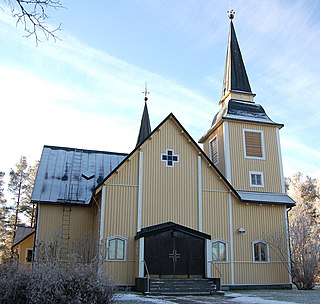Colloquial Finnish and spoken Finnish refer to the unstandardized spoken variety of the Finnish language, in contrast with the standardized form of the language. It is used primarily in personal communication and varies somewhat between the different dialects.
Unless otherwise noted, statements in this article refer to Standard Finnish, which is based on the dialect spoken in the former Häme Province in central south Finland. Standard Finnish is used by professional speakers, such as reporters and news presenters on television.

Vaala is a municipality in Finland. It is located in the North Ostrobothnia region. Established in 1954, the municipality has a population of 2,672 and covers an area of 1,764.04 square kilometres (681.10 sq mi) of which 461.45 km2 (178.17 sq mi) is water. The population density is 2.05 inhabitants per square kilometre (5.3/sq mi). Previously Vaala was part of the Kainuu region but was transferred to Northern Ostrobothnia on 1 January 2016.

Ranua is a municipality of Finland. It is located in the province of Lapland. The municipality has a population of 3,670 and covers an area of 3,694.79 square kilometres (1,426.57 sq mi) of which 241.09 km2 (93.09 sq mi) is water. The population density is 1.06 inhabitants per square kilometre (2.7/sq mi).
Eastern Finnish dialects are chiefly vested in the Savonians and the Karelians. One of the Finnish language spoken group, the North Karelian, represents the East Finnish dialects, however this distinction is not established in any case. Other dialects, such as the North Finnish dialects, are considered as East or West Finnish dialects. Kalevala, one of the earliest and most significant works of Finnish literature, was written in East Finnish and East Finnish features were used extensively in the Finnish language standardization.
Swedish has a large vowel inventory, with nine vowels distinguished in quality and to some degree in quantity, making 18 vowel phonemes in most dialects. Swedish pronunciation of most consonants is similar to that of other Germanic languages. Another notable feature is the pitch accent, which is not found in most European languages.

The Finnic (Fennic) or more precisely Balto-Finniclanguages constitute a branch of the Uralic language family spoken around the Baltic Sea by the Baltic Finnic peoples. There are around 7 million speakers, who live mainly in Finland and Estonia.

The Savonian dialects (Finnish: Savolaismurteet) are forms of the Finnish language spoken in Savonia and other parts of Eastern Finland. Finnish dialects are grouped broadly into Eastern and Western varieties; Savonian dialects are of the Eastern variety.

Rauma dialect is a Southwestern dialect of Finnish spoken in the town of Rauma, Finland.
The phonology of Bengali, like that of its neighbouring Eastern Indo-Aryan languages, is characterised by a wide variety of diphthongs and inherent back vowels.

Finnish is a Uralic language of the Finnic branch, spoken by the majority of the population in Finland and by ethnic Finns outside of Finland. Finnish is one of the two official languages of Finland. In Sweden, both Finnish and Meänkieli are official minority languages. The Kven language, which like Meänkieli is mutually intelligible with Finnish, is spoken in the Norwegian county Troms og Finnmark by a minority group of Finnish descent.

The Peräpohjola dialects are forms of Finnish spoken in Lapland in Finland, Sweden, and Norway. The dialect group belongs to the Western Finnish dialects and it is divided into five more specific dialect groups.
The Crișana dialect is one of the dialects of the Romanian language (Daco-Romanian). Its geographic distribution covers approximately the historical region of Crișana, in western Transylvania.

Koillismaa is a subdivision of Northern Ostrobothnia and one of the Sub-regions of Finland since 2009.
Proto-Finnic or Proto-Baltic-Finnic is the common ancestor of the Finnic languages, which include the national languages Finnish and Estonian. Proto-Finnic is not attested in any texts, but has been reconstructed by linguists. Proto-Finnic is itself descended ultimately from Proto-Uralic.

Ingrian is a nearly extinct Finnic language of Russia. The spoken language remains unstandardised, and as such statements below are about the four known dialects of Ingrian and in particular the two extant dialects.

South Ostrobothnian dialect is a Western Finnish dialect. It is traditionally spoken in the region of South Ostrobothnia and parts of Coastal Ostrobothnia. The South Ostrobothnian dialect has many features that are unique to the region of South Ostrobothnia.

Värmland Finnish dialect is an extinct Savonian dialect spoken in Värmland by the Forest Finns. However some speakers also lived in Norway.

Central and Northern Ostrobothnian dialects are Western Finnish dialects spoken in Northern and Central Ostrobothnia, as well as in the Ranua municipality in Lapland. The dialects have been influenced by the Savonian dialects, the influence is weaker at the coasts and stronger in the inland areas.

Tavastian dialects are Western Finnish dialects spoken in parts of Western and Southern Finland. The dialect spoken in the city of Tampere is part of the Tavastian dialects. The Tavastian dialects have influenced other Finnish dialects.













